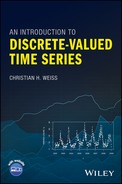Part III
Monitoring Discrete-Valued Processes
In Parts I and II , we learned about models for discrete-valued processes and how to fit them to the given time series data. Once an appropriate model for the considered process has been found, it can be applied with respect to the further course of the process. The perhaps most common application of a given model is to forecast future realizations of the process, a topic that was discussed earlier in this book in the context of each of the respective models, especially in Section 2.7. In the following, we focus on another field for applying fitted models, namely the monitoring of the process. This is often called statistical process control (SPC). Instead of predicting outcomes conforming with the process model, the aim of SPC is to detect a possible deviation from the assumed (in-control) model as early as possible, but certainly without producing false alarms all the time. This might be useful in detecting the outbreak of disease epidemics, the deterioration of customer service, or a malfunction during production. An important tool for process monitoring is the control chart, or, more precisely in the context of a discrete-valued process, the attributes control chart. As a new observation arrives, a control statistic is computed and plotted on the chart; if the statistic violates the chart's control limits, an alarm is triggered to indicate that the process has possibly run out of control.
After providing a brief introduction to the discipline of SPC in general in Section 8.1, the remaining sections of Chapter 8 deal with types of control charts for count processes, where the ![]() th control statistic is computed based on the counts available up to time
th control statistic is computed based on the counts available up to time ![]() . Approaches like Shewhart, cumulative sum (CUSUM) and exponentially weighted moving-average (EWMA) control charts are discussed, together with the corresponding chart design and ways of analyzing their performance. Then in Chapter 9, analogous issues are considered for the case of categorical processes. Here, one strategy is to take samples from the process and to determine the frequency distribution of the categories within each sample. This information is used to compute the statistic to be plotted on the chart. Continuous process monitoring is also possible, where each new observation is accompanied by a new control statistic.
. Approaches like Shewhart, cumulative sum (CUSUM) and exponentially weighted moving-average (EWMA) control charts are discussed, together with the corresponding chart design and ways of analyzing their performance. Then in Chapter 9, analogous issues are considered for the case of categorical processes. Here, one strategy is to take samples from the process and to determine the frequency distribution of the categories within each sample. This information is used to compute the statistic to be plotted on the chart. Continuous process monitoring is also possible, where each new observation is accompanied by a new control statistic.
